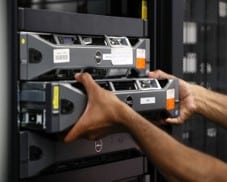
Servium & Linedata: Efficient Server Relocation & IT Migration Services

Migration Project Phases
1.
Pre Migration Activities
When the government announced the first ease of the lockdown, Linedata advised that it would be their preference to migrate their server equipment within three weeks. This was not in line with Technimove’s recommended timelines to ensure a successful low-risk outcome. However, Technimove are always focussed on assisting the customer and providing the utmost flexibility, therefore the team was ready to go above and beyond to ensure that the project was completed successfully to the highest possible standards against the tight timescales. Technimove commenced the process by performing a full Physical & Tracing Audit of the environment.
2.
Physical & Tracing Audit
The information captured during a Physical and Tracing Audit was required to be able to design the new environment and designate the switch ports that the server ports will connect to. Our Audit includes the following:
Serial numbers and existing rack and U location of all devices
The ports populated on each device, i.e. Nic 1 – RJ45, Nic 2 – Fibre etc
Labelling both ends of all dedicated, interconnecting cables (such as SCSIs)
Once the Physical Audit was completed, Technimove proceeded to the Cable Tracing. This involved tracing all the cables from server to switch end. This provided a higher level of detail on the cabling configuration. With this process completed, Technimove could provide a patching schedule of the original site.
3.
Document Consultation
Technimove provided a senior engineer to work side by side with the customer to establish the configuration at the target site and produce the destination patching schedule. Technimove’s Senior Engineer, and On-Site Project Coordinator, used his skills and extensive experience to assist the client to ensure best practices were followed and the desired outcome was achieved.
4.
Pre-Cable
Once the destination patching schedule was finalised, Technimove attended the destination site to commence the Pre-Cable. Technimove recommends Pre-Cabling, as it minimizes downtime and reduces risk on the Migration day. Since all equipment was being relocated, the Technimove team were greeted with empty racks. Technimove engineers followed the information provided on the patching schedule to establish the rack name and “U” positions of each server and switch, to run the cables to the appropriate length. Cable Velcro was than used to manage the cables to the correct “U”. All cables were labelled with the device and port information, making patching an easier process on Migration day. For this project, the Technimove Team were required to run cables above the racks in overhead trays, therefore ladders were essential. The Onsite Project Coordinator ensured that Health & Safety Guidelines were adhered to.
5.
Migration Planning
Several conference calls took place between all parties. Technimove ensured that both Servium and Linedata were informed of the outcomes of all pre-migration activities, highlighting the risks involved. Due to COVID-19, Linedata’s IT manager could not be onsite for the Pre-Cable, and therefore sign-offs were obtained with pictures and email confirmation.
Technimove’s Projects Team worked with Servium and Linedata to plan the Migration and ensure that all activities were performed within the strict timelines. A Migration Plan was drawn up and several Technimove teams were assigned duties and responsibilities.
6.
Migration
The Migration took place on a Friday evening. As part of the scope, Technimove were also required to supply a Technical Engineer to perform pre-checks and post-checks on the EMC equipment. This ensured that the warranty on the EMC devices is validated. The EMC Technical Engineer commenced the Migration by performing pre-checks to confirm there were no errors and the equipment was safe to be powered down and relocated. Once this was completed, the client went ahead to power down all the equipment.
Once the Technimove Migration Team received confirmation of the successful shutdown, the engineers commenced by removing all dedicated cables, ensuring they are labelled and packed securely. The team then proceeded to de-commission all equipment, de-racking each device one by one, wrapping into antistatic bubble wrap, before placing it into foam-lined flightcases.

Due to COVID-19, Technimove engineers were required to wear face masks and adhere to the 2-metre social distancing rule, as much as possible while on-site. Technimove conducted a Risk Assessment, provided full PPE and enforced the appropriate safety measures, in line with the government guidelines.
Once all equipment was de-racked and packed, flightcases were wheeled to the vans and loaded securely via ramp. Linedata requested that some critical equipment should be transported in a separate vehicle. Therefore, Technimove provided an additional vehicle to ensure the customer’s peace of mind.
The equipment was then transported to the destination site without any scheduled stops.
At the destination site, the Technimove Team unloaded the flightcases and wheeled them to the designated racks. All equipment was then racked into the pre-cabled racks in line with the rack plans provided. The client had previously identified that some of the equipment needed to be prioritised. Technimove ensured that these devices were the first to be racked and patched. This meant that Linedata were able to access this equipment and commence their power up and testing, before the rest of the equipment was installed.
Once all equipment was racked, the Technimove team completed the re-commission, ensuring all cables were neatly dressed and managed efficiently. Technimove follow a well-honed cable management methodology, following best practice and ensuring that the result is not only efficient and practical, but also a work of art.
